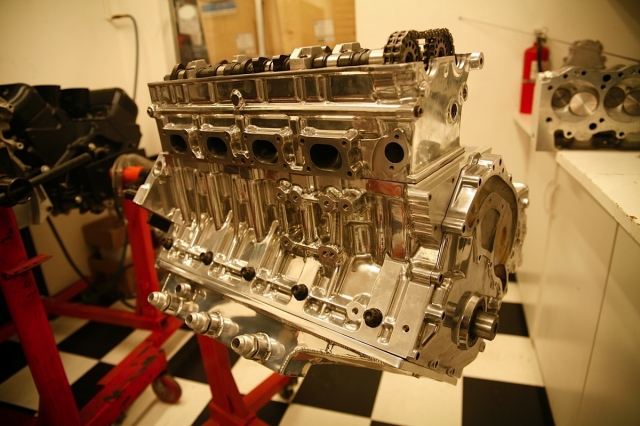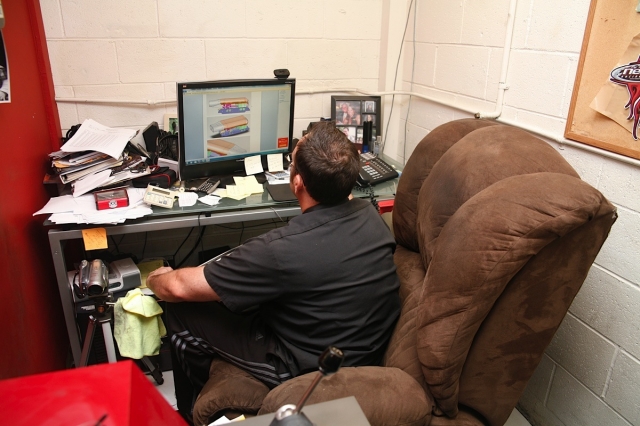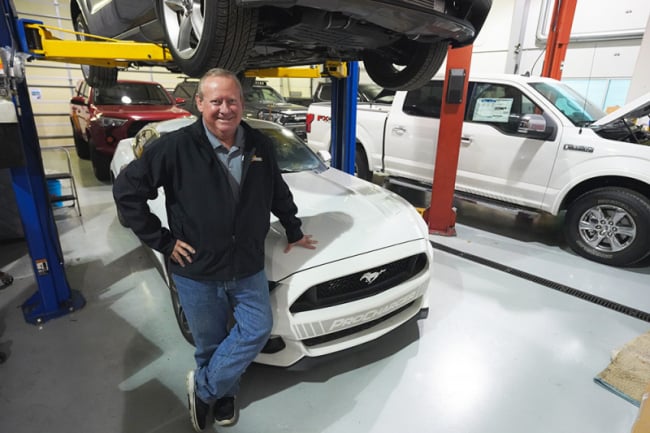 “We’re not just an engine builder anymore. We’re much more than that now.”
“We’re not just an engine builder anymore. We’re much more than that now.”
Those words come from Tom Nelson of Nelson Racing Engines (NRE), builder of show-ready, twin-turbo bullets that make insane horsepower while maintaining civility and drivability on the street.
Nelson wrote a personal mission statement at the tender age of 13 and has steadily achieved the long-term goals he set for himself. His automotive lust started from tagging along with his dad to the races. A second-hand go-kart spawned a neighborhood detail business and launched the entrepreneur spirit in his soul. Building engines out his grandmother’s garage then gave birth to NRE. A few years later he purchased a DTS dyno-equipped machine shop and set up operations in a Chatsworth, California, industrial park. Soon, NRE will move into a new facility which, like Nelson’s opening quote says, is much more than just an engine shop. But more on that later.
Nelson fell in love with turbochargers through his father’s twin-turbo Pantera, but he first entered into a lengthy foray of building blown big-blocks for offshore boat companies. Then he turned his attention almost 100-percent to turbocharged engines, developing a twin-turbo small-block Chevy package that he took to the 1999 PRI show.
“Back then, people would believe the power we were making with our twin-turbo motors but they just didn’t think they were streetable,” remembers Nelson.
The F-bomb Camaro
He needed a high-profile vehicle to validate the package. Months of badgering Hot Rod editor David Freiburger led to the now famous F-bomb Camaro project with NRE’s signature 1,400-horsepower small-block. That car not only made power and was civil on the street, it launched Nelson Supercars. Nelson already employed body-and-paint man Scott Carpenter, and then he acquired Red Zone Fabrication to add a complete chassis and fabrication shop to the NRE mix.
Nelson struggled to earn a profit with low-budget engines in the early years. When he doubled his prices, he says the business tripled. One would think that building engines or complete cars for customers with a water-cooled checkbook could be a real pain, as they often have a micro-managing personality. But Nelson recounts only good experiences.
NRE’s Alien intake is whittled out of a single chunk of billet aluminum, making it not just pretty but also a complete assembly. Shown in the right photo are the bottom and top halves. Note in the bottom half, the secondary fuel rail machined into the mid-plate. The secondary injectors are sandwiched between the base and mid-plate and fed by this orifice. In testing, Nelson learned that extreme reversion was actually sucking the upper intake downward like a beer can, even though it’s a thick chunk of billet. To solve the problem, the Alien upper now has integral, internal strengthening ribs not shown on this prototype.
“Almost always I get full creative freedom. Some guys want to do something that’s whacky, like a motor with four different colors or something, but if it makes me look bad I’m not going to do it. If I’m going to work on it, I need to be stoked about it. You don’t want a guy working on a car just for a paycheck because the car will be junk. Everybody has to be happy about working on it,” says Nelson, noting the most difficult customers are usually the budget-based ones. “The rich guys are pretty hands-off after they tell me what they want because they have other stuff going on. The budget guy might be in danger of having his lights shut off if he spends too much to change a camshaft, you know? It makes a difference.”
Left is the entire regulator system of the Alien, made of a billet plate that bolts to the back of the upper plenum. On either side are the regulators (with return lines exiting from the bottom) that are boost-referenced through ports in the upper, and the primary and secondary fuel inlets (lower and upper, respectively). A separate primary fuel rail runs between the port runners. Shown in the right photo are the butterflies that are actuated by heim-join linkage. This same linkage piece also actuates the TPS located under the plenum assembly.
The school of boost abuse
He also used his boat-engine experience to advance the shop’s high-end aspirations.
“If you’re ever going to learn how to build a motor, offshore marine is where you learn to do it,” says Nelson.
Marine engines taught him the importance of the fine details and understanding the ugly problems that surface under the constant, full-throttle, high-stress loads off boat racing.
Here is the symmetrical design of NRE’s turbos. They come in 72mm and 88mm sizes. You can see how the NRE turbos make the plumbing configuration much simpler and better looking on a Hemi. Initially done just for aesthetics, Nelson says that power is up to the tune of 100 ponies with the 72mm setup. He also reports that both relief valves open at the same time, as opposed to a slight delay between them with conventional turbos.
Even though we make big power, we’re not just building drag race motors. — Tom Nelson, NRE
Big boost from a 14-71 Roots blower also taught Nelson the importance of piston-deck thickness, wrist-pin-boss strength and the exhaust side of the valvetrain — including the lobe design and shape, pushrods and rockers.
“With all that boost in the chamber, it’s really hard to get the exhaust valve open. We were snapping rocker arms and breaking everything, and you learn from what breaks,” says Nelson, who applied those lessons to twin-turbo combinations. “We had built a few turbo boat motors and I called them ‘two for ones’ since they made twice the power as the blower motors in the same basic package.”
Learning the ins and outs of turbochargers and their relationship to power curves and engine dynamics was not an overnight awakening. Unfortunately, the advice from many “experts” threw him off the path. Through trial and error, however, he mastered the craft and even developed unique, patented parts — such as the Alien intake and symmetrical turbochargers.
The Alien intake and symmetrical turbos
At first, Nelson relied on a Hogan sheet-metal intake manifold that, for twin-turbo setups, needed a throttle body, two injectors per runner, two fuel rails for the 16 injectors, two regulators, two return lines, a MAP sensor, a coolant temp sensor and a nightmare of hard-line plumbing. To save the time and money, Nelson developed billet aluminum intakes for small- and big-block Chevys with all necessary components in one attractive piece that’s easier to install and roughly the same price as separate parts.
The dyno room at NRE is constantly in use, in this case about to run a naturally aspirated (yes he does those too) big-block Chevy. The dyno is a DTS Power Mark. The engine assembly room is small and usually packed with engines.
Turbocharger technology has increased by enormous leaps, but the turbo housing “packages” have all been basically similar, with the relationship between the air-in and the air-out on the compressor side the same between all types of turbos. Nelson wanted to simplify the plumbing on his engines and improve the appearance, so he partnered with Turbonetics to develop a pair of symmetrical turbos, meaning they’re a mirror-image of one another. Turbonetics builds the turbos while NRE has the exclusive sales and marketing contract.

Can you identify this engine? It’s a custom LT5 from a ’90 ZR1. NRE reengineered the 500ci big-bore block on the computer with Solidworks, then cut it on a Haas CNC machine from billet aluminum. The LT5 heads are stock. Nelson is shooting for around 900 horsepower naturally aspirated. Another project is a billet-based V16 engine.
Two factors help differentiate NRE from other engine builders. First, Nelson takes a unique approach to twin-turbo engines.
“Even though we make big power, we’re not just building drag race motors. I build you a turbo motor you can drive wherever you want. It comes with fabricated headers, an intercooler, a fuel management system, two Aeromotive pumps, Electromotive computer already programmed, all the wiring—everything you need out of one shop,” explains Nelson. “Most people buy an engine from one guy, have someone else build the headers, another guy put it in, and another guy still do the tuning. And when there’s a problem everyone points fingers at someone else. Not here, since we give you the whole deal.”
NRE fabricates its own symmetrical headers for the twin-turbo packages, with billet collectors and flanges for the wastegates, for a durable header that will never crack.
NRE Employees
While Tom Nelson gets all the credit, he has a highly talented crew from all automotive disciplines. They are:
- Drew Whaley: Engine Machinist/Assembly
- Rudy Martinez: Plumbing specialist
- Victor Salas: Fabricator Welder
- Mike Romero: Sheetmetal specialist/fabricator
- Brad Parker: Shipping
- Chris Holoubek: Accouting
- Larry Lewis: Sales
- Larry Bjork: engine machinist
- Dillion Morrison: Shop Driver
- Daniel Morrison: Manager
- James Graziano: Engine Machinist
- Dave Staurinou: Fabrication and chassis
- Scott Carpenter: Painter/Bodyman
- Donny Booker: Bodyman
- Cole Balster: Engineering
Nelson Supercars
NRE ships between 50 and 75 complete engine packages per year, and potential customers are given a wait time of roughly one year. But he’s also available after the sale — a policy demonstrated while tuning an engine from his office chair during the customer’s 267-mph pass at the Bonneville Salt Flats.
“I could see what the engine and driver were doing,” says Nelson. “I could see when he wasn’t at wide-open throttle, everything. I was talking to the driver during the pass, and I made sure to add fuel as he was coming out of the 5-mile marker to save the motor.”
Another difference is Nelson Supercars, the one-stop car-building shop; so Nelson Racing Engines is poised to morph into Nelson Racing Enterprises to better define the company’s capabilities and manifest Nelson’s childhood mission statement.
“My ultimate goal, a huge part of that mission statement when I was 13, is to build my own car,” he beams.
That’s an ambitious goal, especially in light of hot rod shops going out of business every day, but Nelson believes that building a car is important to his success with the engine packages.
“Doing a whole car makes me a much better engine builder. “When I go to design a cooling or electrical system, I learn what does and doesn’t work and it makes me a better engine builder,” says Nelson. “I know what the customer is going to have to deal with if he buys an engine package and does the rest himself.”

Nelson designs his custom parts, including the Alien, in Solidworks in this tiny, cramped “office” at the back of the engine shop. That’s the handle for the DTS Power Mark dyno in the foreground, and his financial department is a small desk just behind where the photographer is standing.






























